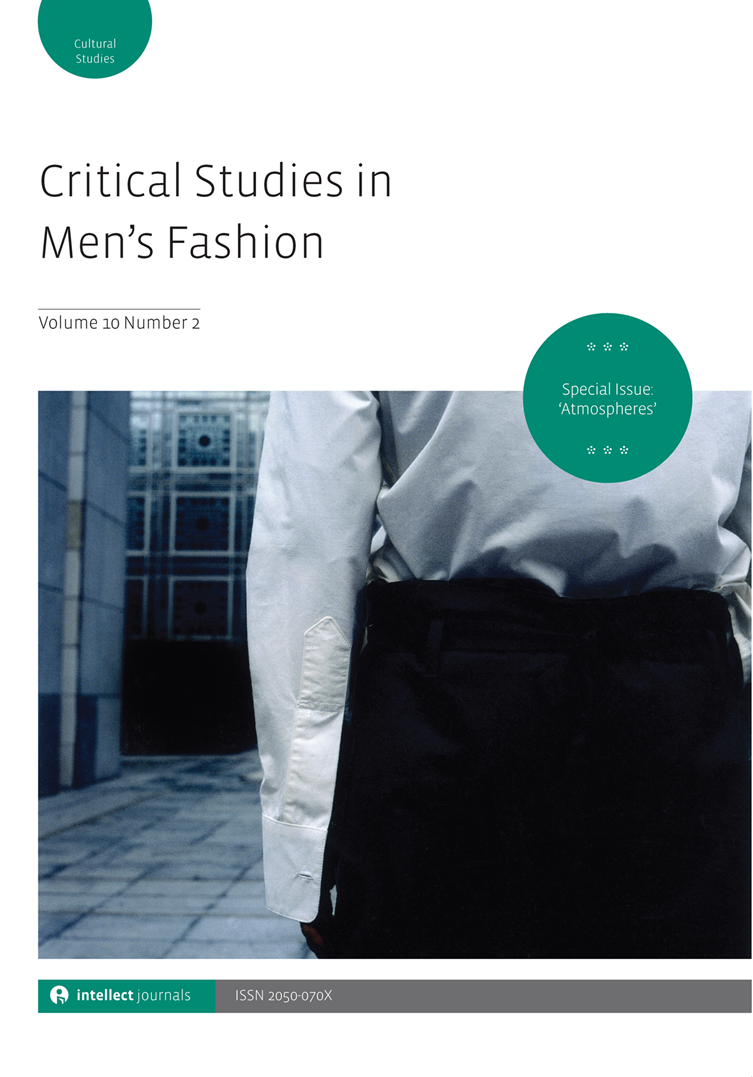- Home
- A-Z Publications
- Critical Studies in Men's Fashion
- Previous Issues
- Volume 2, Issue 1, 2015
Critical Studies in Men's Fashion - Volume 2, Issue 1, 2015
Volume 2, Issue 1, 2015
-
-
Dapper dudes: Young men’s fashion consumption and expressions of masculinity
More LessAuthors: Ben Barry and Dylan MartinAbstractMen’s fashion is offering a growing selection of diverse and gender-blurring clothing for mainstream male consumers. This research explores the influence of these contemporary clothing trends on the dressing practices and gendered identities of style-conscious young men – a group of consumers whose voices are scarce in fashion research. Findings from the Canadian sample reveal that young men develop an idiosyncratic and creative sense of style to express their identities. While shifts in menswear and culture have inspired them to participate in fashion, social norms continue to prevent men from fully experimenting with dress. This study reveals the factors that influence young men’s fashion consumption and highlights changes in their consumer practices, including their use of social media. Fashion professionals will glean an understanding of Generation Y men’s fashion consumption habits and attitudes. They are advised to develop brands that focus on creativity and community to reach this audience.
-
-
-
Hedi Slimane and the reinvention of menswear
More LessAbstractThis article analyses the role of designer Hedi Slimane in shaping the development of menswear in the first decade of the twenty-first century. Slimane’s collections for Dior Homme in the early 2000s caught the imagination of the fashion press with their combination of a radically slim silhouette, precise tailoring and androgynous flourishes. Along with the commercial success he brought to Dior, Slimane catalyzed a renewed interest in menswear, the aesthetic he proposed acting as a prototype for men’s fashion throughout the decade. By contrasting Slimane’s slender, ambiguous and self-consciously elegant look with the sporty muscularity of the 1990s catwalk, the article explores the shifting nature of male identity in the new millennium as fashionable men found new ways of consuming their masculinity.
-
-
-
To have and to hold: Masculinity and the clutch bag
More LessAbstractThe recent popularity of the male clutch bag provides an opportunity to explore men’s attitudes to dress and gender. An atypical item of menswear because it is not particularly cost effective or practical, the clutch bag is a sartorial ‘handicap’. Like many items of expensive luggage and sartorial prop that have deprived men of the use of one of their hands, from walking canes to military batons, the patent limitations of the clutch bag express the financial and social confidence of its owner. The clutch bag is a specific example of a more general trend among menswear accessories that highlight a more assertive, even aggressive, masculinity. It seems no coincidence that this attitude should be expressed materially at a time when men’s societal role is being questioned and the top-handle bag, which signifies the socio-economic abilities of women, not least through its association with Margaret Thatcher, is in vogue.
-
-
-
Andean clothing, gender and indigeneity in Colonial Period Latin America
More LessAbstractThe material culture approach taken in this article combines theoretical perspectives on exchange in value and the gendered body politic. This theoretical framework is applied to three elements of costume changes in the early Colonial Period (c. 1532–1825) of the Andean highlands of South America. The impact of Spanish public policies, gender roles and social ideals is examined for the maskaypacha scarlet forehead fringe, the form and decorations on male Inkan unku tunics and decorative motifs on textiles. I argue that changes in indigenous dress are largely confined to males in the early Colonial Period, which mirrors the gendered nature of the Spanish body politic. This material culture reading of indigenous clothing changes provides a useful model for analysing the gendered categories of indigenous political symbols and costumes today as well as in more recent history.
-
-
-
Stepping out in bathers: Displaying masculinities in F. Scott Fitzgerald, Ernest Hemingway and Willa Cather
More LessBy Sarah HeatonAbstractThere is a moment in post-World War I literature when the American male steps out semi-clad in bathers. At the shoreline these men in swimwear display new expressions of masculinity combined with the old to expose the flaws in society. In the revealing and concealing of men�s bodies and masculinities there is a residual anxiety despite the confidence with which these men emerge at the water�s edge, and despite the legitimizing sports aesthetic that swimwear affords their �nakedness�. This article explores the depiction of the semi-clad man at the shoreline: The bright young men in bathers in F. Scott Fitzgerald�s Tender is the Night ([1934] 1986), and The Great Gatsby ([1926] 1979), to his Movie mogul who cannot swim in The Last Tycoon ([1941] 1987) are moments of crisis and revelation. For Ernest Hemingway in Fiesta, The Sun also Rises ([1927] 2004) and The Garden of Eden ([1987] 1994) men donning their bathers experience a cleansing and rebirth. Whilst Willa Cather in The Professor�s House ([1925] 1990) unites a sense of display and assuredness of masculinity in the revelation of the male nakedness and swimming. The shoreline emerges as a liminal space that allows masculinities to be performed, displayed, explored and habituated.
-
-
-
Reviews
More LessAuthors: Mario J. Roman, Jessica Schwartz and Olenka MartynyukAbstractBachelors of a Different Sort: Queer Aesthetics, Material Culture and the Modern Interior in Britain, John Potvin (2014) Manchester: Manchester University Press, 306 pp. ISBN: 9780719084997, h/bk, �75.00
The Glamour of Italian Fashion since 1945, Sonnet Stanfill (2014) London: V&A Publishing, 287 pp. ISBN: 9781851777761, h/bk, �30/$48
Yves Saint Laurent, Jalil Lespert (2014) USA: The Weinstein Company
-
Most Read This Month


